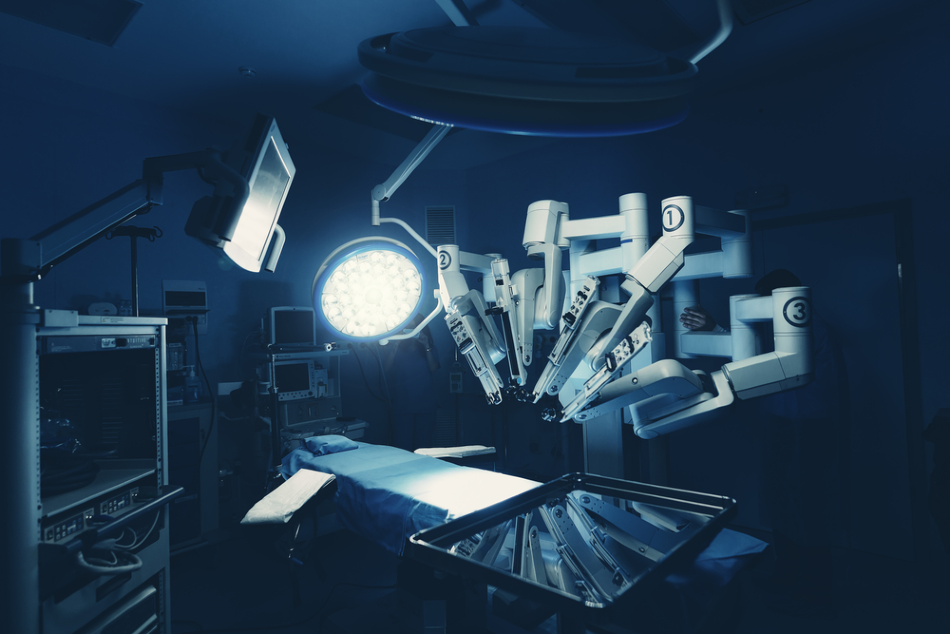Oct 3 2012

Image Credit: MAD.vertise/Shutterstock.com
Article updated on 24/02/20 by Stephen Edgar
Based on statistics by Cancer Research UK, in 2016 it was estimated that 47,740 men were diagnosed with prostate cancer. Prostate cancer accounts for 26% of all new cancer cases in males in the UK (2016). The current statistics highlight the importance of finding new treatment options for prostate cancer. Apart from some of the traditional treatments for this form of cancer including radiation, LHRH agonists/antagonists, and cryotherapy, radical prostatectomy (such as retropubic, perineal, and robot-assisted laparoscopy) offer the most long-term solution to treating this type of malignant neoplasm. Since 2000, one of the most used robotic laparoscopic procedures has been the da Vinci-assisted robot prostatectomy.
The da Vinci Robot
One radical treatment for prostate cancer is based on the removal of the prostate glandular tissue, which carries many more risks as the incision into the tissue is between 8 to 10 inches and this can cause a large amount of blood loss, complicate the recovery time, and in certain circumstances lead to impotence. Even when the procedure is conventional laparoscopic (keyhole), clinicians have been concerned about the time taken to perform the procedure. These complications have become the inspiration for developing quicker, less invasive techniques with increased precision – the da Vinci robot is regarded as the most advanced robotic tool for the safe and precise practice of a prostatectomy.
This state-of-the-art surgical system comprises the following parts:
Console – this platform allows the surgeon to sit and watch a 3D image of the precise surgical field. There are several controls on the console positioned under the display and these are manually operated by the surgeon. The surgeon can control the movement of the surgical instruments positioned inside the surgical field.
Patient-side Cart – This element of the robot consists of up to four robotic instrument arms that perform the surgical procedure under the surgeon’s control (i.e., making an incision). One of the four instrument arms is designed to conduct a laparoscopy. This arm can pivot at a distance of 1–2 cm, which aims to minimize any surrounding tissue from being compromised.
EndoWrist Instruments – These instruments have seven degrees of flexibility to ensure that the operating instrument is as dextrous as the human hand as the robot needs to be able to match the precise movements of the surgeon. Each instrument is designed to perform movements including clamping, suturing and tissue manipulation whilst still maintaining the full integrity of surround tissue.
Vision System – The 3D imaging system is paramount to providing a detailed view of the operating field.
[The following video demonstrates the principles of the da Vinci robot and provides a clear comparison between the benefits of using an advanced intuitive tool and a traditional surgical procedure for conducting a prostatectomy.]
da Vinci Prostatectomy Patient Video
[The next video is a clear 3D animation of a robotic prostatectomy. The video demonstrates how the robotic instruments accomplish movement in many directions to perform incisions in the prostate tissue. The key point to note with this demonstration is that the nerves and blood vessels that maintain sexual function should still be preserved following completion of the surgical procedure.]
Weill Cornell Robotic Prostatectomy: 3-D Animation (2/6)
Advantages
Open prostatectomy involves making a 5–7 cm incision along the patient’s abdomen to access the operating field. However, with robotic-assisted laparoscopic prostatectomy, there are smaller incisions with less pain, which results in minimal cosmetic damage to the tissue. Smaller incisions mean less blood loss and improved recovery time.
The imaging technology incorporated into the da Vinci robotic system provides a precise depth of the operating field, allowing full scale of the hand movement, which can be accurately translated into movement of the instrument arms in the operating field.
Using the da Vinci robotic system for a prostatectomy reduces the chances of the patient experiencing impotence and incontinence due to the increased precision during surgery and minimal damage to surrounding blood vessels and nerves.
Disadvantages
A successful prostatectomy will vary between patients and there are risks with any surgical procedure. Such robot-assisted surgical procedures are still surgeon dependent so the accuracy of the outcome will be based on the surgeon’s skill with this system.
Challenges
The main challenge with robot-assisted prostatectomy is to protect the surrounding tissue to help preserve functionality in potency while maintaining cancer control. Robot surgery has advanced as an alternative solution applied in several surgical fields including urology, gynecology, and cardiothoracic specialties. A major issue is ensuring that the surgeon can master any new skills associated with the development of surgical robotic systems – standardization and communication of procedures and control of robots to assist in surgery needs further attention to achieve perfection in manipulating this system.
References and Further Reading